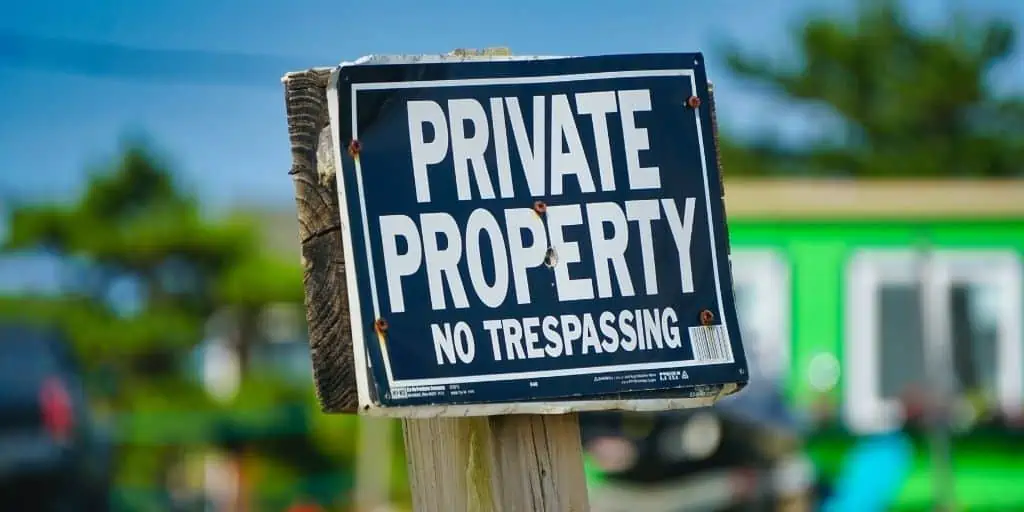REtipster does not provide legal advice. The information in this article can be impacted by many unique variables. Always consult with a qualified legal professional before taking action.
Something every vacant landowner should be aware of is the nuisance and potential liability of trespassers.
In my experience of owning hundreds of lots all over the country, this has never presented any serious problems for me, but every property is different.
If you have any concerns about someone wandering onto your property and causing damage or hurting themselves, there is something you can do to protect yourself.
What Is Trespassing Exactly?
In broad terms, trespassing is when someone enters or stays on your property without your consent, but each state has its own specification.
In fact, each state has variations on many things with regard to trespassing, so get educated about the state specifics you need to be aware of (more on that below).
Why Post No Trespassing Signs?
There are at least two reasons to do this:
1. Protect Yourself Against Liability
As unlikely as it may seem, there is always a chance that someone could wander onto your property (intentionally or unintentionally), hurt themselves, and sue you for it.
If you can show evidence that you had NO TRESPASSING signs around the perimeter of your property in accordance with your state's statutes, this could work in your favor. There is a benefit to showing that a trespasser clearly walked past this kind of visible warning and entered the property at their own risk.
This isn’t the same kind of protection as an insurance policy or LLC to shield your personal assets, but it could be a helpful piece of evidence to have in your corner.
2. Legal Recourse Against Trespassers, Thieves, and Vandals
The consequences of trespassing onto someone’s property vary from state to state and depend on what kind of trespassing is done.
For example, breaking into someone’s home or habitation is different than wandering into a school, hospital, or railroad that is off-limits to the public. The consequences can be considered a felony or misdemeanor, it may include fines or jail time, and the penalty may be more severe if significant damage is done to the property.
Posting these signs is a way to make sure you have the highest possible recourse against a trespasser.
For instance, if someone goes onto your land and steals something of value, without a sign, the trespasser could just be charged with theft. However, with a sign, they could be charged with theft, PLUS trespassing, PLUS burglary.
It's also important to note that in some states, a trespasser can essentially claim ignorance that they were trespassing on a property and no signs were present, since they had no way of knowing they were on private property. One way to eliminate this defense is to post signs around your property in accordance with your state statutes to make it completely obvious.
Sometimes this means posting signs at all the points of entry (paths, trails, roads, or driveways onto the property), sometimes it means posting them every 100 feet, and in some states, posting signs makes very little difference, trespassing is trespassing whether there is a posted sign or not… but in most cases, having signs posted isn’t going to hurt anything.
What Works as a NO TRESPASSING Sign? (Interactive Map)
There is no single, standard, “no trespassing” sign or set of rules that applies to all 50 states. The requirements of size, color, and wording of a sign can differ from one state to another because trespassing laws vary across the country. Because of these variations, it's a good idea to get familiar with the statutes in your state so you can make sure you're posting the right kind of signs that works in your area.
If you're looking for a quick reference on how to find the rules in your state, this interactive map can help you find the relevant information in your state quickly.
Legal Disclaimer: This map is not a substitute for legal advice. This information can be impacted by regional legislation and other unique variables. Always consult with a qualified legal professional in your area before taking action.
When Can You Use Paint?
Several states have a purple paint law (and in some states, the paint can be orange, yellow, or red), specifying the color of paint that serves as a no trespassing symbol against hunting, fishing, or trapping while letting you know you are on private property. Because property owners often have a hard time keeping posted signs posted or undamaged, using paint marks, in addition to or instead of signage, can be an effective way to mark property in the same way. This tends to be most cost-effective and permanent, requiring very little maintenance.
Although the laws in these purple paint states are similar, there are some variations by state.
For example, in Pennsylvania, purple paint on trees or posts is a lawful posting method in all but two counties. The law requires that vertical purple lines must be at least 8 inches long and 1 inch wide. The bottom of the mark must not be less than 3 feet or more than 5 feet from the ground. And painted marks must not be more than 100 feet apart.
In Montana, the paint needs to be fluorescent orange.
Every state is different and the laws throughout the country are constantly changing, so be sure to understand the current laws in your area before you start painting trees and posts on your property.
Pro Tips When Posting No Trespassing Signs
If you're going to take the step of posting signs or paint on your property in accordance with your state's laws, there are some important things to keep in mind.
Get a Survey
It’s not a bad idea to get a survey before you put these up, so you don’t make the mistake of posting these on your neighbor’s property instead of your own.
Keep the Signs Up
Once these signs are up, you don’t need to make another visit to the property to take them down after the property is sold. Chances are, the new property owner will want them up too. And if not, they can take them down.
Use Signs That Are Sized Correctly
Make sure the sign is big enough to comply with your state’s statutes. Every state has different minimum measurements (and most signs you’ll find at your local store or on Amazon will work in most states).
Post Signs in the Correct Places
Make sure your signs are posted by all the natural entry points (especially the big, obvious ones, like roads or paths), so a trespasser can’t miss them. A good rule of thumb in most states is to post them 100 feet apart from one another.
Space Your Signs Correctly
Don’t post multiple signs right next to each other. It can become an eyesore and there are rules against this in some states.
Make Sure Your Signs Are Worded Correctly
Make sure your signs say the right thing to comply with your state’s rules. Similar to the size requirements, most generic signs are made to apply to most states, but it’s worth double-checking.
Post Them Permanently
Make sure it’s nailed up in a permanent fashion so the weather or a person would have a hard time taking it down.
Remember that in several states, you can use purple paint on a post or tree. Unlike a sign, paint is much less likely to be removed by a person or weather. Not all states allow this though, and some states use other paint colors.











